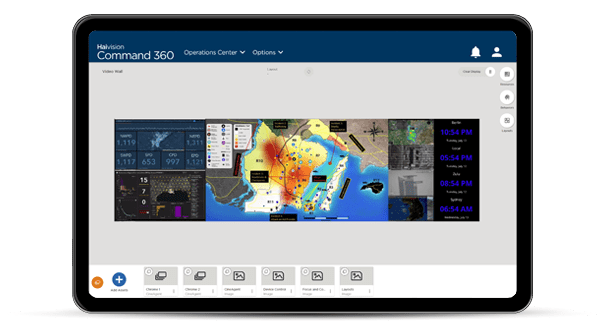Global Security Operations Centers (GSOCs) are designed to monitor, detect, analyze, and facilitate response to security threats. These environments manage all stages of threat control. GSOCs enable organizations to mitigate economic risk, protect assets, raise situational awareness, and safeguard personnel. Visualization and communication tools provide the essential conduit to accomplish GSOC missions.
Security operations used to segregate traditionally mechanical and analog monitoring systems from digital cybersecurity teams. Accelerated advances in technology in recent years are closing the gap between these entities. Security operations are evolving in tandem with increasingly integrated cyber physical systems and the Internet of Things (IoT). All industries are experiencing a convergence of multiple technologies with automated functionality, embedded systems, and machine learning.
Future-proofing global security operations requires adoption of a comprehensive visual collaboration platform. More than simple ‘video wall display,’ a dynamic platform checks all the boxes for real-time control, assessment, and response.
Dynamic Content Management
A powerful content management system allows security operations teams to maintain situational awareness for simultaneous incidents among distributed locations. The right user experience incorporates the following:
- Simplified user controls
- Execution on multiple operating systems
- Browser-based interface
- Intuitive operation
- Centralized device management
- Instant organization, placement, and interactive control of assets
- Ease-of-use regardless of technical background
Remote Operation and Decision Making
Prior to 2020, few people could have predicted the impact a global pandemic would have on mission-critical operations. The COVID-19 crisis spawned new workflows across all industries as organizations adapted to social distancing mandates. More workers than ever started working from home and continue to do so even as restrictions are lifted.
GSOCs typically monitor highly sensitive, classified intelligence 24/7/365 in extremely secure physical spaces. Remote work presented unique challenges that other on-site work environments didn’t encounter. Historically, having operators, analysts, and leadership in the same space offered a single unified experience. Immediate, in-person access to all levels of GSOC personnel and data eliminated communication obstacles.
However, current and future trends tell us command and control strategies can no longer assume all decision makers are in the same room. The visual collaboration platform must securely accommodate a decentralized audience without losing efficiency. Successful response is measured in seconds and minutes, not hours and days.
URL-Based Graphical Content Loading
Security Ops Centers depend heavily on URL and application sources for video analytics, cybersecurity assessment, geospatial data, social media monitoring, and more. As these sources compete for network bandwidth, operator desktops get co-opted for website access, becoming ad-hoc servers. This is not a viable, long-term solution as it overloads equipment being used for unintended purposes. The strain on network resources consequently compromises system performance. High-resolution, robust streaming of URL-based or memory-heavy graphics-driven applications require dedicated servers designed for such display. Data visualization will only become more complex and multi-faceted in the future, not less.
A state-of-the-art visual collaboration system combines high-performance streaming and control of URL-based content. Strong content management allows operators to interact with and annotate websites. Simultaneously sharing such content with on-site and remote viewers ensures all stakeholders consume the same information.
Global Common Operating Picture (GCOP)
Regardless of whether threats occur due to social tensions or natural disasters, GSOCs provide essential intelligence and analytics for leadership. This data, collected from diverse, distributed sources, comprise a Global Common Operating Picture (GCOP). A continuously updated GCOP informs decision makers in real-time to proactively assess vulnerabilities. It also helps operators mitigate any impact to public safety and control incident aftermath.
A forward-thinking GSOC operates cohesively whether under a single unified experience or through a distributed, socially distanced workforce. Likewise, it must prove scalable as operations grow. System performance, data integrity, and content quality must be maintained even when jurisdiction expands to multiple sites. Instant and simultaneous access remains essential regardless of how many sites comprise a GSOC’s virtual footprint. A visual collaboration system equipped with KVM over IP functionality supports GSOC scalability and GCOP execution. Secure KVM implementation reduces the amount of hardware in control rooms while still delivering seamless streaming to and from remote locations.
We recently hosted a webinar to help organizations adopt a proactive, forward thinking design strategy for new or upgraded global security operations centers. Our friends at McKesson and Cox Enterprises joined us to share their unique perspective and extensive expertise on topics which most impact their operations, including:
- New physical and cybersecurity threats (8:02)
- Upgrading and building a SOC (12:20)
- Monitoring the increase in content sources (20:30)
- Handling the impact of COVID-19 and remote work (25:58)
- Dynamically adapting to converging situations (29:10)
- Importance of ease-of-use (34:18)
- Scaling your GSOC (37:54)
- Transitioning to Enterprise Risk Management (42:41)
- Ensuring revenue protection (43:56)
- Establishing a common security standard (45:14)
